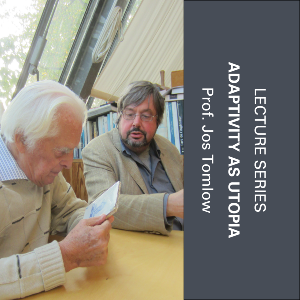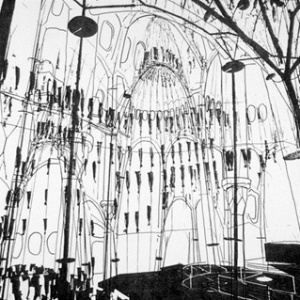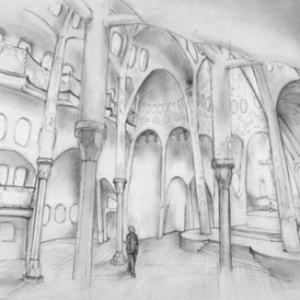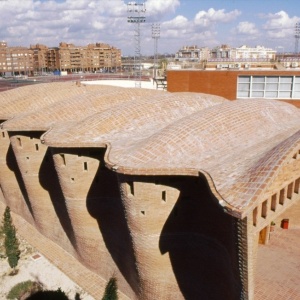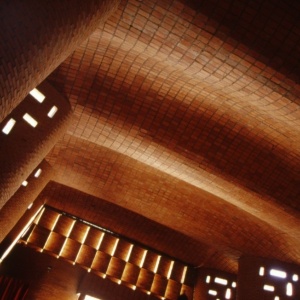| Time: | September 21, 2023, 6:00 p.m. (CEST) |
|---|---|
| Event language: | English |
| Venue: | Institut für Leichtbau Entwerfen und Konstruieren Pfaffenwaldring 14 70569 Stuttgart |
| Download as iCal: |
|
We are pleased to invite you to the guest lecture by Prof. Jos Tomlow from the University of applied sciences in Zittau/Görlitz.
Title: “Methodological aspects of historic hanging models in comparison with the work of Anton Gaudi and Eladio Dieste.”
When: Thursday, 21/09/2023 at 6pm
Where: ILEK, Pfaffenwaldring 14.
After the lecture, we invite you to join us for a small get-together. There will be snacks and drinks while you have the opportunity to talk and socialise with all the participants. This will be a wonderful opportunity to share ideas about the topic and make new connections.
Registration: pr@ilek.uni-stuttgart.de
Abstract
Since the reconstruction of Gaudís hanging model (Rainer Graefe, Frei Otto, Jos Tomlow, Arnold Walz), with the Gaudí reserch Group Delft at the IL in Stuttgart, 1983, structural Form finding has found a culmination point/moment of static theory: Colonia Güell Church near Barcelona around 1900. Earlier and later interesting samples exist of applications of the reversion of the catenary (chain line) as a way to generate an optimized arch shape. The contribution of a range of individuals, including Wilhelm Tappe, Carl-Anton Henschel, Heinrich Hübsch, Gaudí & Jujol, and Frei Otto, often in relation to commercial or sociological inovative visions, also sustainability, are presented.
The second part of the lecture tells the story how Eladio Dieste‘s invention of Cerámica Armada, (brick shells), toook place in the year 1947, in Casa Berlingieri, a house design by Antonio Bonet Castellanas at the Rio Plata atlantic shore. In a historical introduction, vault and shell shapes are compared with the vast amount of shells by Dieste and his firm. Form-finding methods by Dieste, started with the catenary shape, which he later fused with complex gausian geometry. They evolve in an architecture of organic shapes. His opus magna, the Cristo Obrero church in L'Atlántida, became a Wold Heritage site in 2021. From a sustainable view point of view, Diestes vaults of hollow bricks with a pre stressed cement layer on top, are lighter than reinforced concrete shells of similar span. Repair after long years – partially necessary - were done with regional technology. Dieste always tried to avoid the use of North-American expensive technology, inventing his own machinery. Source: Eladio Dieste, der Ingenieur aus Uruguay, der uns die Ziegelschale vorführte, by Jos Tomlow, Pre-print, Hochschule Zittau/Görlitz 2017.
Short Bio
Jos Tomlow, born 1951 in Roermond, Netherlands, is a Professor of art history and architecture at the University of applied sciences Zittau/Görlitz (Germany, 1995-2017). Member of DOCOMOMO International Specialist Committee - Technology and Construction History Society, Gesellschaft für Bautechnikgeschichte, Koldewey Gesellschaft, Cuypersgenootschap. He is an architectural engineer at the Technical University of Delft (NL, 1982), and he earned a PhD, on the reconstruction of Gaudí’s hanging model, 1986, from the University of Stuttgart, where he was scientific assistant to Frei Otto and Werner Sobek at the Institute of Lightweight Structures in Stuttgart on the “History of Structural design” project.
Major fields: Construction history, lightweight structures and hanging models, building physics, applications of complex geometry. International activities on conservation, city planning history, modelling, measured drawings, consult.
Publications: The model, 1989. Der Zittauer Ring, with V. Dudeck, 2000. Das Grenzlandtheater in Zittau (1934-1936), with S. Spitzner-Schmieder 2015, Co-editor of DOCOMOMO preservation technology dossier 9, Climate and Building Physics in the Modern Movement, 2006 and dossier 13, Perceived Technologies in the Modern Movement 1918 - 1975, 2014. Gaudí’s reluctant attitude towards the inverted catenary, in: Engineering History and Heritage, Volume 164, Issue EH4, November 2011, p. 219-233. Eladio Dieste, der Ingenieur aus Uruguay, der uns die Ziegelschale vorführte, Pre-print, Hochschule Zittau/Görlitz 2017. Observations on design and building of the Roman Segovia Aqueduct, in: Proceedings 7th International Congress on Construction History, Lisbon, 12–16 July 2021, Volume 2, p. 225-231. With S. Stadler (CAD), Vorentwürfe eines Ökohauses in Warmbronn - Energetische Studien zu Frei Ottos Ökohaus-Konzept (1967-1969). Wissenschaftliche Berichte Hochschule Zittau/Görlitz, Heft 136/2021, Beiträge Nr. 2772-2774, Hrsg. Alexander Kratsch, Textband/Bildband ISBN: 978-3-941521-31-5 (Preprint), Zittau 2022


